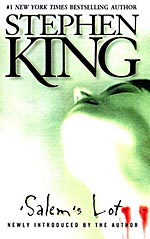
![]() charlesdee
charlesdee
11/3/2013
![]()
I do not believe that when Stephen King wrote Salem's Lot he set out to write the Great American Vampire Novel. He published his book in 1975, and there was just not enough competition in the field to make such an ambition feasible. Anne Rice published Interview with the Vampire one year later and opened the floodgates on a genre whose sludge we continue to wade through. Most bookstores now have special sections dedicated to "Paranormal Romance," a genre aimed largely at teenage girls and their spiritual descendents.
What King did create with Salem's Lot was the "All-American Vampire Novel," the Our Town of vampire novels. His small New England town of Jerusalem's Lot is a funhouse-mirror version of Thornton Wilder's Grover's Corner. The stories and the settings are separated by almost seventy years, but each is a slice of Americana, although King's story, both by virtue of the times it takes place in and his own sordid tendencies, contains considerably more alcoholism, adultery, child abuse, and of course those blood-sucking fiends.
King walks us through some typical days in "Salem's Lot," introducing us to characters from the various strata of small town society. We meet decent ordinary folk, some pretty sorry excuses for human beings, some people haunted by their own demons. None of them are prepared for the evil coming their way. Salem's Lot has known evil before. The Marston House, a derelict mansion perched on a hill overlooking the town, was inhabited by a depraved brother and sister in the 1920's. It was the scene of a murder/suicide that continues to exert such an influence on the small town that I wondered why they had never demolished the place. But a town like Salem's Lot needs a haunted house, something to scare the local kids and remain a source or perverse pride. When the house sells to an unseen Mr. Barlow and his local representative Straker, word is they plan to convert a local laundromat into an antique store aimed at the tourist trade. "Probably queer on each other," is the whispered opinion around town. Although the book is essentially humorless, King does have fun leading his sheep to the slaughter.
The best parts of Salem's Lot all come pretty early on, as King introduces his characters and sets up the situation. I found I had no emotional investment even in the ostensible heroes of the story and was for the most part only curious to see how and when characters were done in. (A prologue lets the reader know right off who will survive.) As characters meet their inevitable demises, the story slows down. This has the danger of becoming my tiresome refrain as I read and review horror fiction, but I thought the whole thing could have wrapped up a good hundred pages sooner than it did.
And as a vampire villain, Barlow is as traditional as they come. This could be because in 1975 there was no pressure on a writer to rethink the vampire tradition. Or it could have been King's intention to take a character who is essentially Count Dracula, remove him from crumbling castles and the Carpathian Mountains, and stick him among soda fountains, trailer homes, city dumps, and antagonists who go to the local library to read up on best methods of defeating him. But by keeping Barlow as such a traditional character, King's book becomes dated. Our heroes arm themselves with wooden stakes, crucifixes, and holy water. Those locals turned by Barlow float outside windows, slip under doorways, and vanish into thin air. At least no one becomes a bat.
http://www.potatoweather.blogspot.com